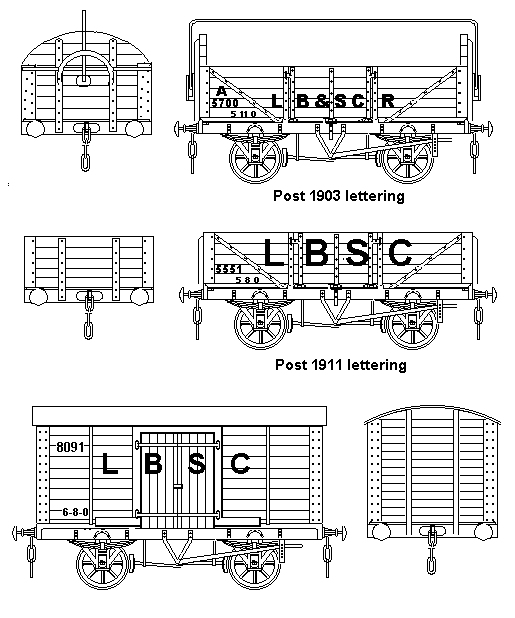
London Brighton and South Coast Railway
(Note: Numbers in brackets refer to specific references)
The LBSC, usually called just 'The Brighton', was formed by the amalgamation of the London & Croydon Railway and the London & Brighton Railway in 1846. The LBSC operated from Victoria station in London and served no less than eight race courses, including both Epsom and Goodwood. There was regular horse box traffic but with no coal fields in its territory it had to pay freight charges on all the coal it used, resulting in generally higher passenger fares than was common. The LBSC extended only about eighty miles from the centre of London but the system comprised seven separate lines serving the south coast where it maintained no less than ten termini. The principal stations were at Brighton, Croydon, Shoreham, Chichester, in the west and St.Leonards in the east, Portsmouth, Newhaven, Horsham and Eastbourne It was the LBSC which began the electrification of South London, although it favoured an overhead wire and pantograph rather than the third rail which was to become dominant. The LBSC introduced the first British 'slip carriage' service in 1858, dropping off the coach at Haywards Heath. The Pullman coaches, famous for their use on the 'Brighton Belle' service, were introduced in 1870's. All the southern companies were primarily concerned with their intensive passenger services but the LBSC served the ports of Newhaven and Littlehampton where, from the 1860's, regular steamer services were maintained to the Continent, Newhaven was served by a grande vitesse goods train. The London to Brighton line was the most important route to the company, there was a major goods depot in Bermondsey (London) and another at Lovers Walk in Brighton
Prior to 1870 the goods stock was probably painted light grey with black ironwork. From 1870 to 1895 goods stock bodies and solebars were painted lavender (light) grey, the ironwork on the solebars was also grey but that on the body was picked out in black Van roofs were white, rapidly greying in service. Number plates were white lettering on a bright blue background, these show up clearly and it is worth adding a blob of Humbrol 'oxford blue' with some white dots on it to a model chassis. The rather elaborate 'illiterate' mark, placed toward the upper left of the body, was a 9 inch diameter pale blue circle around a white shield shaded black with a red cross on it. Lettering was white and 3" high shaded black. A letter indicating the class of open was to the left of the illiterate's mark. The wagon number was centred one plank below the illiterate's mark. Tare weight in 3" white letters is at the left hand end of the solebar. Brake van ends were painted vermilion red.
From 1895 the body colour became a darker shade of grey and the illiterate mark was replaced by LB&SCRy in nine inch high lettering with the "y" underlined with a line and a dot. In some cases the letters were shaded black. The wagon number was normally 6" high, tare weight were 3¼" high and appeared on the body sides and the solebar. The class letter appeared over the number.
In 1903 the lettering was abbreviated to LB&SCR and brake van ends were painted in the body colour.
From 1911 the body colour was changed to an even darker grey, similar to GWR wagon grey, and ironwork was no longer painted black. The company initials L B S C being painted about 18 inches high and the wagon number about 5 inches high, usually in the lower left of the body with the tare weight in lettering about three inches high..
Early passenger livery was plain varnished mahogany and at least some non passenger coaching stock was in a similar livery. In 1903 they changed to using an orange/brown colour ('raw umber") with white or cream upper panels for passenger coaches, very similar to the Pullman passenger coach livery.
Fig ____ LBSCR

The rather 'vintage' looking twin bolster wagon was described in Article XX (xx xx RM), it was made using a Peco ten foot wheelbase chassis with extended ends cut from a fifteen foot wheelbase chassis and with a shortened Peco bolster wagon body with the sides sanded smooth to represent timber.
The hoop ended wagon with folded down tarpaulin bar is a Peco five plank wagon kit with the top plank sanded down to match the rest. The ends are 1mm scribed card and the end supports were cut away and replaced with 20x20 thou strip for strength. The sheet supporter and its associated end hoops are made from florists steel 'rose wire'.
The iron cornered van is a Peco 'ventilated van' body, shortened and fitted with new sides. The door appertures were cut out and scribed card 'vertical planked' doors fitted, this does require a little care however the framing around the door, 10x20 thou strip, can be used to cover the join. The corner plates were added using 10 thou card and the end supports are 20x20 thou strip.
References:
(1) An Illustrated History of Southern Wagons Vol 2 (LBSCR & Minor Companies)
G. Bixley A. Blackburn, R. Chorley, M. King, J. Newton ISBN 0 86093 220 6
Second in a series of four, covers goods liveries and wagon design in considerable detail.
(2) LBSCR Stock Book. The preserved locomotives, carriages and wagons of the London Brighton and South Coast Railway - P. Cooper. Runpast Publishing, Cheltenham, Gloucstershire, 1990. (ISBN 1 870754 13 1). Contains information on preserved LB&SCR stock.
Societies:
Available Models
Achnowledgements